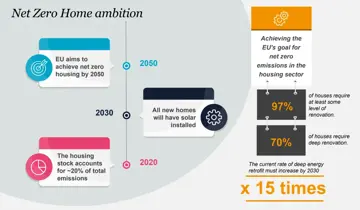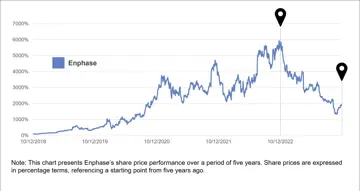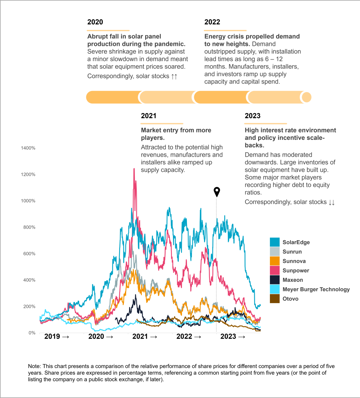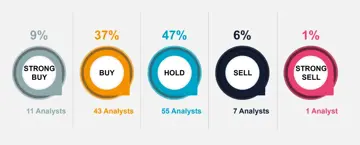Shining a light on solar stocks
Energy transition Investment Energy research Solar & battery research C&I research
Let’s start with the long-term view. The European Union (EU) has set the goal of achieving net zero housing by 2050. As it stands, Europe’s housing stock, comprising over 200 million dwellings, accounts for around 20% of Europe’s total emissions.
Last week, the final text of the European Performance of Buildings Directive was agreed. Each EU Member State will have interim goals, such as all newbuild homes to have renewables, namely solar, installed from 2030 onwards.
As for existing dwellings? The truth is, we have a lot of old and energy-inefficient homes. According to BPIE, 97% of them will require at least some level of renovation to reach net zero. Of which 70% will require deep renovation, where energy consumption is reduced by at least 60%.
Europe’s current rate of deep energy renovations is about 0.2% per year. Which means, to reach our 2050 goal of net zero emissions for the European housing market, it would require us to increase that rate by 15 times, so that we’re averaging at 3% per year throughout the period 2030 to 2050. Solar PV, along with improving energy efficiency (e.g., upgraded insulation and ventilation, smart controls, and high-efficiency appliances) and low carbon heating alternatives (e.g., heat pumps and district heating) will be key measures. As will optimising performance through energy storage and home energy management systems (HEM).

With solar PV playing a pivotal role in Europe’s energy transition future, why have share prices of major residential solar market players plummeted recently?
Here’s the backstory. And it goes beyond Europe.
In 2023 to date, Enphase – global solar inverter, battery, and HEM market player – has seen its share price fall by around 60%.
Figure 2: Enphase – Relative share price performance (5 year period)

The share price of fellow solar inverter heavyweight, SolarEdge, has seen a similar trend, falling 71% in 2023 so far.
Likewise, solar technology developers, Maxeon and Meyer Burger Technology AG’s share price also lost more than half their values in 2023.
The same story applies in 2023 further down the supply chain. USA residential solar installation market leaders, Sunrun, Sunpower, and Sunnova experienced declines in share price ranging from 30% to 70%. While European solar marketplace company, Otovo, lost almost 90% of its equity value from its peak in the summer of 2022.
There are several reasons behind this, but chief amongst them is the dynamics between supply and demand (see timeline below).

Additional items to note:
- What happens in China’s solar manufacturing industry has wide-reaching implications for global solar equipment supply. This was seen during the pandemic when strict lockdown measures resulted in a dramatic stalling in solar panel production.
- For international solar companies that have high exposure to major residential solar markets like California, the Netherlands and Poland – many will see their revenues nosedive in 2023 as changes to net-metering schemes dampen customer demand. These changes have resulted in less solar export compensation rates for solar households.
We are now living in a high-interest world, so let’s dissect what this means a little deeper in relation to solar stock prices.
Many Solar-as-a-Service companies (that offer leasing and power purchase agreement contracts) finance their portfolio of solar PV systems through debt. In a high interest rate environment, the cost of financing their systems have increased, reducing margins. Sunrun, Sunnova, and Sunpower are the largest Solar-as-a-Service companies in terms of customer base.
The higher interest rates also decrease the present value of future cash flows. Again, Solar-as-a-Service companies will be particularly hit hard because the ‘value’ of their 10-20 year contracts (i.e. future revenues) will reduce.
Companies will have to service debt (of which the cost is increasing) regardless of trading performance. When a company has a high amount of debt compared to equity (the case with some of these solar companies), its financing structure becomes more susceptible to downturns in the economy and the business cycle.
All the above could make investors move capital away (impacting share prices) if they perceive solar stocks to be riskier, or simply because they can generate a better return from other investments.
In summary, rising interest rates can put pressure on the price of solar stocks by increasing capital costs, affecting company valuations, and potentially leading to shifts in investor sentiment and economic activity.
Why do we remain optimistic about the solar market?
If one accepts the idea that central bank interest rates have peaked, and that we are gradually moving into a post-subsidy world for residential solar, then our thesis is as follows:
- There will be a period of adjustment on both the supply and demand side in the short-term. Market players will look to refinance at lower rates when these become available. While customers will assess whether the cost of doing nothing (i.e., not installing solar panels) is worth it, against a backdrop of (1) potentially more volatile retail electricity prices and (2) increased electrification of the home and mobility.
- The financial markets and rating agencies in Europe are starting to warm up to solar scale-ups and “zero-to-low upfront cost” offerings like solar loans and leasing. Green finance paired with a downward trend in solar equipment prices, makes solar more affordable and will give it mass-market appeal.
- There will be increased market consolidation and heightened investment flows over the next 5 years. Those that retain and secure sizeable market shares will be those that are:
- able to tackle key customer pain-points (e.g., reduce high upfront CapEx).
- have back-end, digital infrastructures that enable them to minimise cost and satisfy customers.
- As we inch closer to that 2050 net zero home target, we expect governments to take stronger measures (possibly even introduce compliance-based regulations).
All this points to a bright future for residential solar and why we expect solar stocks to rebound at some point. Supportive of our optimistic view, we cross-checked this with equity analyst positions across the stocks of the eight solar companies in the charts above. Almost half of the 117 analysts recommended a “Buy” or “Strong Buy” of these stocks, with most of the remainder recommending a “Hold” position to investors.
Only 7% maintained a Sell or Strong Sell position.
Figure 4: Equity analyst recommendations (as at 7 Dec 2023)

All in all, our research, with solar market projections to 2030, indicates that the European residential solar market is moving in the right direction, despite this short-term bump in the road.
This publication is intended as a subjective analysis piece for information and general thought-generation purposes only. It does not constitute advice (professional, financial or otherwise) and may not be relied upon by the reader for investment decisions. The information contained herein is based upon publicly available information and we accept no responsibility for its accuracy or completeness.
Unlock deeper insights on LCP Delta's subscription portal
Check out our portalSubscribe to our thinking
Get relevant insights, leading perspectives and event invitations delivered right to your inbox.
Get started to select your preferences.




